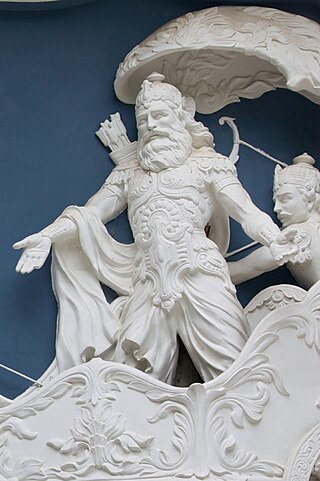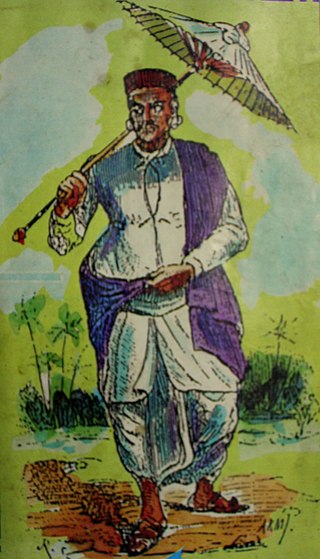Related Research Articles

Kshatriya is one of the four varnas of Hindu society and is associated with the warrior aristocracy. The Sanskrit term kṣatriyaḥ is used in the context of later Vedic society wherein members were organised into four classes: brahmin, kshatriya, vaishya, and shudra.
The Other Backward Class (OBC) is a collective term used by the Government of India to classify castes that are educationally or socially backward. It is one of several official classifications of the population of India, along with general castes, Scheduled Castes and Scheduled Tribes (SCs and STs). The OBCs were found to comprise 52% of the country's population by the Mandal Commission report of 1980 and were determined to be 41% in 2006 when the National Sample Survey Organisation took place. There is substantial debate over the exact number of OBCs in India; it is generally estimated to be sizable, but many believe that it is higher than the figures quoted by either the Mandal Commission or the National Sample Survey.
Sanskritisation is a term in sociology which refers to the process by which castes or tribes placed lower in the caste hierarchy seek upward mobility by emulating the rituals and practices of the dominant castes or upper castes. It is a process similar to "passing" in sociological terms. This term was made popular by Indian sociologist M. N. Srinivas in the 1950s. Sanskritisation has in particular been observed among mid-ranked members of caste-based social hierarchies.
Chandraseniya Kayastha Prabhu (CKP) or historically and commonly known as Chandraseniya Prabhu or just Prabhu is an ethnic group mainly found in Gujarat and Maharashtra. Historically, they made equally good warriors, statesmen as well as writers. They held the posts such as Deshpande and Gadkari according to the historian, B.R. Sunthankar, produced some of the best warriors in Maharashtrian history.

Teli is a caste traditionally occupied in the oil pressing and trade in India, Nepal and Pakistan. Members may be either Hindu or Muslim; Muslim Teli are called Roshandaar or Teli Malik.
The caste system in Goa consists of various Jātis or sub-castes found among Hindus belonging to the four varnas, as well as those outside of them. A variation of the traditional Hindu caste system was also retained by the Goan Catholic community.
Panchal or Panchal-Brahmin is a Master Craftsman caste of India. Panchal is a collective term for class of engineers, architects, priests, sculptors and temple builders. They are Brahmins and belong to Poursheya Brahmins sect. They belong to the Vishwakarma sect and are also known as Panchal Brahmin.

The Nambudiri, also transliterated as Nampoothiri, Nambūdiri, Namboodiri, Namboothiri and Nampūtiri, are a Malayali Brahmin caste, native to what is now the state of Kerala, India, where they constituted part of the traditional feudal elite. Headed by the Azhvanchery Thamprakkal Samrāṭ, the Nambudiris were the highest ranking caste in Kerala. They owned a large portion of the land in the region of Malabar, and together with the Nair monarchs, the Nambudiris formed the landed aristocracy known as the Jenmimar, until the Kerala Land Reforms starting in 1957. Naturalized Tulu Brahmins who took up Nambudiri customary ways are known as Embranthiri Brahmins.

Newar caste system is the system by which Newārs, the historical inhabitants of Kathmandu Valley, are divided into groups on the basis of Vedic varna model and divided according to their hereditary occupations. First introduced at the time of the Licchavis, the Newar caste system assumed its present shape during the medieval Malla period. The Newar caste structure resembles more closely to North India and Madheshis than that of the Khas 'Parbatiyas' in that all four Varna and untouchables are represented. The social structure of Newars is unique as it is the last remaining example of a pre-Islamic North Indic civilisation in which Buddhist elements enjoy equal status with the Brahmanic elements.

The caste system in India is the paradigmatic ethnographic instance of social classification based on castes. It has its origins in ancient India, and was transformed by various ruling elites in medieval, early-modern, and modern India, especially in the aftermath of the collapse of the Mughal Empire and the establishment of the British Raj. It is today the basis of affirmative action programmes in India as enforced through its constitution. The caste system consists of two different concepts, varna and jati, which may be regarded as different levels of analysis of this system.

In India, a caste, although a western stratification arrived from Portuguese word Casta and Latin word castus, is a social group where membership is decided by birth. Broadly, Indian castes are legally divided into Forward Castes, Other Backward Classes, Scheduled Castes, and Scheduled Tribes. Indian Christians and Indian Muslims are also function as castes. With castes separating individuals into different social groups, it follows that each group will have conflicting interests; oftentimes putting those with lower social standing in less favorable positions. The Constitutuent Assembly which was head by B.R. Ambedkar, the founder of the Depressed Classes Association which had originally put forward these demands, created the reservation system, which essentially acts as affirmative action to provide representation to caste groups that have been systematically disadvantaged. However other castes which have not been provided reservations, have called this system unfair and politically motivated. There have also been other cases where political parties, like the Bahujan Samaj Party (BSP), was formed to represent the minority or lower communities.

The Daivadnya,, is a community from Goa and Karnataka, who claim to have descended from Vishwakarma. Although they claim themselves to be Brahmin, but these claims are not accepted by others including local Brahmin castes. They are native to the Konkan and are mainly found in the states of Goa and Damaon, Canara, coastal Maharashtra, and Kerala. Daivadnyas in the state of Maharashtra and Karnataka are classified by National Commission for Backward Classes as an Other Backward Class.
Bhumihar, also locally called Bhuinhar and Babhan, is a Hindu caste mainly found in Bihar, the Purvanchal region of Uttar Pradesh, Jharkhand, the Bundelkhand region of Madhya Pradesh, and Nepal.
Kaniyar is a caste from the Indian state of Kerala. There are regional variations in the name used to define them. They are listed under the Other Backward Communities (OBC) by the Kerala Government.
Yadav, Jadam, or Jadav refers to a grouping of traditionally non-elite, peasant-pastoral communities or castes in India that since the 19th and 20th centuries have claimed descent from the mythological king Yadu as a part of a movement of social and political resurgence. The term Yadav now covers many traditional peasant-pastoral castes such as Ahirs of the Hindi belt and the Gavli of Maharashtra.
Satani is a community that renders temple services in the states of Andhra Pradesh, Karnataka, Tamil Nadu and Telangana in India. Traditionally, they have rendered a variety of services as supervisors and purohits of minor temples, guardians of temple properties, heralds, singers and torch-bearers at festivals, bodyguards of Jiyars, and providers of umbrellas, flower garlands, and namam clay. They have claimed Brahmin status, although this has been contested by Brahmins as they do not wear the sacred thread and they do not study or chant/recite Sanskrit Vedas or Gayatri Mantra, but they study and recite only Naalayira Divya Prabandham written by Alvars. They are currently included in the Other Backward Classes (OBC) list by the central and state governments.
The Vishwakarma community are a social group of India, sometimes described as a caste. They prefer the alternate name, Vishwabrahmin, and claim themselves to be Brahmin or of high-status in the caste hierarchy, although these claims are not generally accepted outside the community. The community comprises five subgroups—carpenters, blacksmiths, bronze smiths, goldsmiths and stonemasons— claim to be descendants of Vishvakarma, the builder and architect of heavenly realm, a Hindu deity.
The 'Prabhu caste' or Prabhu communities are a group of related Hindu castes belonging to the former ruling caste of statesmen, bureaucrats and aristocrats of Northern districts of Konkan region in Maharashtra, India. There are four such castes, all having different ritual and social status within the caste system of Maharashtra, but all of them having traditions traced back to the 12th century which label them as endogamous subdivisions of Kshatriyas of Solar ans Lunar descent. They are Chandraseniya Kayastha Prabhu, Pathare Prabhu, Kanchole Prabhus and the Danved Prabhu.
The Backward Caste movement in Bihar can be traced back to the formation of Triveni Sangh, a caste coalition and political party, in the 1930s, which was revived after the introduction of land reforms in the 1950s aimed at removing intermediaries from agrarian society. But, this drive could not succeed in bringing long-lasting changes in the condition of lower strata of society, as they lacked political representation and economic power. The period since land reform included caste conflicts and the class struggle which eventually led to a transfer of absolute political power in the hands of Backward Castes, who had been kept away from it earlier. The class struggle succeeded the struggle of some of the Upper Backward Castes against the sacerdotal authorities for improvement in their ritual status. By the 1990s, the conflict between upper-castes and the lower-castes continued, with nearly 17 massacres taking place during this time period. But with the advent of politics of social justice and the Janata Dal in the 1990s, the lower caste became more active politically.
Brahmanical System of Education was an ancient system of education in ancient India. It was based on Vedic tradition. The main objective of the educational system was to make the students self-reliant. The curriculum of the system was based on Vedas. The important contributions of the system were developments of Upanishads, six schools of the Indian philosophy and the ancient texts of India.
References
- ↑ "Jyotish Caste and Sakaldwipi Brahmin Same or Not ?". 22 February 2020.
- ↑ "www.bcmbcmw.tn.gov.in" (PDF).